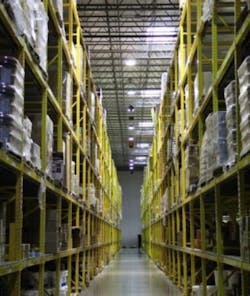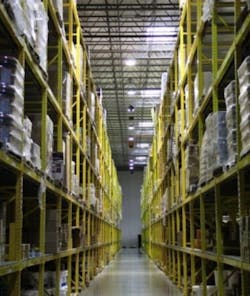Digital Lumens has announced an intelligent lighting installation at the Ace Hardware Retail Support Center in Rocklin, CA that supplies goods to northern California retail stores. The wirelessly-networked lighting delivers 81% energy savings relative to the mix of fluorescent and metal halide (MH) products that were previously used in the warehouse space.
The Digital Lumens system includes ZigBee-wireless-enabled high-bay LED fixtures along with the LightRules lighting management platform that can be used to establish operational settings and to monitor power usage and the health of the luminaires. When the company came to market several years back, it did so with the bold claim of enabling 90% energy savings with the combination of efficient LED technology and occupancy sensors in the luminaires that enable autonomous controls.
In the Ace Hardware case, the retailer acted to upgrade its lighting after utility Pacific Gas & Electric (PG&E) studied the 1-million-ft2 space and projected savings to levels as high as 93% with the use of a networked system with adaptive controls. Indeed, the Digital Lumens technology is especially efficient in warehouse applications where parts of the space can remain dark much of the time, with lights only being brought to functional levels when an operator is in the specific area of the luminaire. For example, we covered a food-supply warehouse that achieved 87% savings with Digital Lumens lighting.
For Ace Hardware, the idea of energy savings was critical because such savings flow directly to its retail stores given the company's business model. "As a member-owned cooperative, every dollar we save using the Digital Lumens system directly benefits our member stores," said Reid Barney, facilities & loss prevention manager for Ace Hardware. "And since lighting is our single biggest energy warehousing expense, reducing lighting-related energy usage by an average of 81% since installing the system translates into extraordinary bottom-line savings. With higher-quality light, we’ve more than doubled the foot candle readings within our facility, resulting in enhanced productivity and employee satisfaction – all while saving massive amounts of energy."
Ace upgraded 1653 fixtures in the project including 1551 T5 florescent fixtures and 102 MH fixtures. The result has been a 39.56% reduction in power usage per square foot plus the savings attributable to adaptive controls. Moreover, the lighting is brighter and more uniform as Barney hinted.
PG&E had studied the Ace Hardware facility for eight months before reporting results to the retailer. Ultimately, the utility recommended the Digital Lumens products because the complete system allowed the company to isolate the lighting system and fully document the savings using the LightRules software.
Digital Lumens said the new lighting extends the latest California Title 24 requirements for commercial lighting. Watch for details on the latest in regulatory codes for lighting projects that will be posted on our site in a few days as part of our Fall special issue.
We asked Digital Lumens if Ace had considered financing the project or using the financial services of an ESCO to access funds. But the company said the two-year payback on the project led the retailer to pay for the project up front — a choice that is increasingly popular as payback periods drop due to lower cost and more efficiecnt LED-based products.







